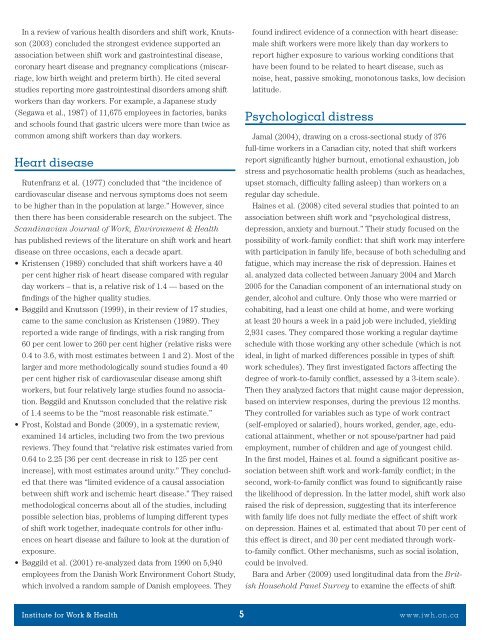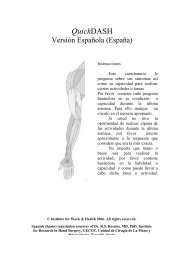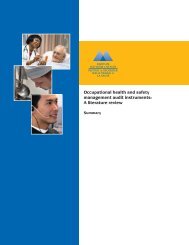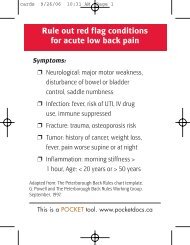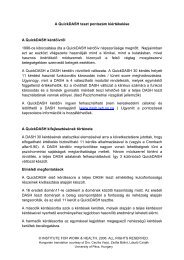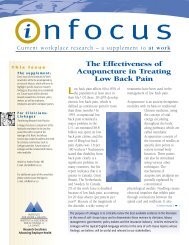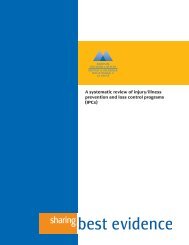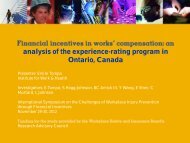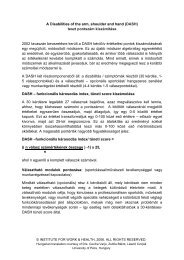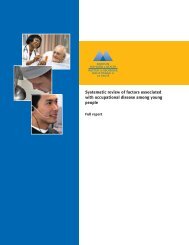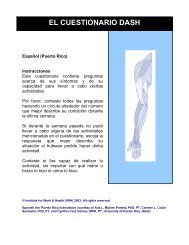Shift work and health - Institute for Work & Health
Shift work and health - Institute for Work & Health
Shift work and health - Institute for Work & Health
Create successful ePaper yourself
Turn your PDF publications into a flip-book with our unique Google optimized e-Paper software.
In a review of various <strong>health</strong> disorders <strong>and</strong> shift <strong>work</strong>, Knutsson(2003) concluded the strongest evidence supported anassociation between shift <strong>work</strong> <strong>and</strong> gastrointestinal disease,coronary heart disease <strong>and</strong> pregnancy complications (miscarriage,low birth weight <strong>and</strong> preterm birth). He cited severalstudies reporting more gastrointestinal disorders among shift<strong>work</strong>ers than day <strong>work</strong>ers. For example, a Japanese study(Segawa et al., 1987) of 11,675 employees in factories, banks<strong>and</strong> schools found that gastric ulcers were more than twice ascommon among shift <strong>work</strong>ers than day <strong>work</strong>ers.Heart diseaseRutenfranz et al. (1977) concluded that “the incidence ofcardiovascular disease <strong>and</strong> nervous symptoms does not seemto be higher than in the population at large.” However, sincethen there has been considerable research on the subject. TheSc<strong>and</strong>inavian Journal of <strong>Work</strong>, Environment & <strong>Health</strong>has published reviews of the literature on shift <strong>work</strong> <strong>and</strong> heartdisease on three occasions, each a decade apart.• Kristensen (1989) concluded that shift <strong>work</strong>ers have a 40per cent higher risk of heart disease compared with regularday <strong>work</strong>ers – that is, a relative risk of 1.4 — based on thefindings of the higher quality studies.• Bøggild <strong>and</strong> Knutsson (1999), in their review of 17 studies,came to the same conclusion as Kristensen (1989). Theyreported a wide range of findings, with a risk ranging from60 per cent lower to 260 per cent higher (relative risks were0.4 to 3.6, with most estimates between 1 <strong>and</strong> 2). Most of thelarger <strong>and</strong> more methodologically sound studies found a 40per cent higher risk of cardiovascular disease among shift<strong>work</strong>ers, but four relatively large studies found no association.Bøggild <strong>and</strong> Knutsson concluded that the relative riskof 1.4 seems to be the “most reasonable risk estimate.”• Frost, Kolstad <strong>and</strong> Bonde (2009), in a systematic review,examined 14 articles, including two from the two previousreviews. They found that “relative risk estimates varied from0.64 to 2.25 [36 per cent decrease in risk to 125 per centincrease], with most estimates around unity.” They concludedthat there was “limited evidence of a causal associationbetween shift <strong>work</strong> <strong>and</strong> ischemic heart disease.” They raisedmethodological concerns about all of the studies, includingpossible selection bias, problems of lumping different typesof shift <strong>work</strong> together, inadequate controls <strong>for</strong> other influenceson heart disease <strong>and</strong> failure to look at the duration ofexposure.• Bøggild et al. (2001) re-analyzed data from 1990 on 5,940employees from the Danish <strong>Work</strong> Environment Cohort Study,which involved a r<strong>and</strong>om sample of Danish employees. Theyfound indirect evidence of a connection with heart disease:male shift <strong>work</strong>ers were more likely than day <strong>work</strong>ers toreport higher exposure to various <strong>work</strong>ing conditions thathave been found to be related to heart disease, such asnoise, heat, passive smoking, monotonous tasks, low decisionlatitude.Psychological distressJamal (2004), drawing on a cross-sectional study of 376full-time <strong>work</strong>ers in a Canadian city, noted that shift <strong>work</strong>ersreport significantly higher burnout, emotional exhaustion, jobstress <strong>and</strong> psychosomatic <strong>health</strong> problems (such as headaches,upset stomach, difficulty falling asleep) than <strong>work</strong>ers on aregular day schedule.Haines et al. (2008) cited several studies that pointed to anassociation between shift <strong>work</strong> <strong>and</strong> “psychological distress,depression, anxiety <strong>and</strong> burnout.” Their study focused on thepossibility of <strong>work</strong>-family conflict: that shift <strong>work</strong> may interferewith participation in family life, because of both scheduling <strong>and</strong>fatigue, which may increase the risk of depression. Haines etal. analyzed data collected between January 2004 <strong>and</strong> March2005 <strong>for</strong> the Canadian component of an international study ongender, alcohol <strong>and</strong> culture. Only those who were married orcohabiting, had a least one child at home, <strong>and</strong> were <strong>work</strong>ingat least 20 hours a week in a paid job were included, yielding2,931 cases. They compared those <strong>work</strong>ing a regular daytimeschedule with those <strong>work</strong>ing any other schedule (which is notideal, in light of marked differences possible in types of shift<strong>work</strong> schedules). They first investigated factors affecting thedegree of <strong>work</strong>-to-family conflict, assessed by a 3-item scale).Then they analyzed factors that might cause major depression,based on interview responses, during the previous 12 months.They controlled <strong>for</strong> variables such as type of <strong>work</strong> contract(self-employed or salaried), hours <strong>work</strong>ed, gender, age, educationalattainment, whether or not spouse/partner had paidemployment, number of children <strong>and</strong> age of youngest child.In the first model, Haines et al. found a significant positive associationbetween shift <strong>work</strong> <strong>and</strong> <strong>work</strong>-family conflict; in thesecond, <strong>work</strong>-to-family conflict was found to significantly raisethe likelihood of depression. In the latter model, shift <strong>work</strong> alsoraised the risk of depression, suggesting that its interferencewith family life does not fully mediate the effect of shift <strong>work</strong>on depression. Haines et al. estimated that about 70 per cent ofthis effect is direct, <strong>and</strong> 30 per cent mediated through <strong>work</strong>to-familyconflict. Other mechanisms, such as social isolation,could be involved.Bara <strong>and</strong> Arber (2009) used longitudinal data from the BritishHousehold Panel Survey to examine the effects of shift<strong>Institute</strong> <strong>for</strong> <strong>Work</strong> & <strong>Health</strong> 5www.iwh.on.ca


